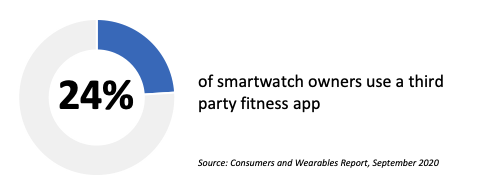
Apple Watch 6
Last week was Apple’s big wearables week. The event started with the obvious: an upgraded version of the Apple Watch that built on the company’s health focus. This year’s big addition was the inclusion of blood oxygen monitoring which will be a popular addition in these pandemic times. Apple says that the Series 6 can check your blood oxygen saturation every 15 seconds and will also check periodically while you sleep. Hardware enhancements also include faster charging (Apple claims 20 percent faster), a more power-efficient processor and a display that’s 2.5 times brighter. Oh, and there is finally support for 5GHz WiFi networks.
The NPD Take:
- The hardware enhancements are, at best, incremental and are unlikely to drive many upgrades. Except, that is, for the blood oxygen monitoring. While Apple is hardly the only device maker to add this feature, it was a necessarily enhancement to protect the company’s base.
An SE version
The Series 6 pricing starts at $399, which has left room for Apple to take another move out of its phone playbook, launching an SE version of the Watch. The Apple Watch SE includes many of the features that you’ll find in the Series 6 but it uses last year’s S5 chip and does not have ECG or the new blood oxygen tracking. But with a price tag of $279, many customers will be okay with the compromises.
The NPD Take:
- We’re a little torn on this one: will a lower priced SE version will broaden the Watch market opportunity? Perhaps. But this market was already fairly well addressed via selling N-1 or N-2 versions of the Watch. As a result, we may see Apple struggle to offload older inventory as consumers hold off waiting for SE versions to launch. A case in point, the Series 5 is currently just $50 more than the SE version.
And fitness training for all
Possibly the most important announcement out of Apple’s big day was the launch of Fitness+, a work out subscription service. Priced at $10 per month (or $80 per year) the service includes ten different exercises (including yoga, cycling, strength and core workouts) that you can follow along with via your iPhone or iPad while the Watch tracks your progress. The integration is key: your iPad screen will, in addition to showing the videos, show your core stats (heartbeat, calories burned and so on) from your watch, thus taking the exercise to the next level.
The NPD Take:
- Many pundits are seeing this as a threat to Peloton, but we’re not convinced. Rather, this will impact the myriad third party fitness apps that run off the back of smartwatches. Peloton is the model that Apple is emulating rather than competing against at this point.
- Having said that, it’s important to remember that Apple has also been looking to drive stronger integration between gym equipment and the Watch as part of a gym-focused synergy. We can expect more gym hardware to come “Apple ready” to capitalize on the new Fitness+ service.


